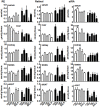Effects of diet and strain on mouse serum and tissue retinoid concentrations
- PMID: 24911926
- PMCID: PMC4049816
- DOI: 10.1371/journal.pone.0099435
Effects of diet and strain on mouse serum and tissue retinoid concentrations
Abstract
The relationship between dietary vitamin A and all-trans-retinoic acid levels in serum and tissues had not been quantified. We determined the impact of dietary vitamin A on retinoid levels in serum, liver, kidney, testis, and epididymal white adipose of five mouse strains: AKR/J; BALB/cByJ; C3H/HeJ; C57BL/6J; 129S1/SvImJ. Retinoids were quantified in mice fed copious vitamin A (lab chow, ≥20 IU/g) followed by one month feeding a vitamin A-sufficient diet (4 IU/g), or after three generations of feeding a vitamin A-sufficient diet. Retinol and retinyl esters were measured by high-performance liquid chromatography with ultraviolet absorbance detection. All-trans-retinoic acid was quantified by liquid chromatography tandem mass spectrometry. The amounts of dietary vitamin A had long-term strain-specific effects on tissue retinyl ester, retinol and all-trans-retinoic acid concentrations. Three generations of feeding a vitamin A-sufficient diet decreased all-trans-retinoic acid in most tissues of most strains, in some cases more than 60%, compared to a diet with copious vitamin A. With both diets, all-trans-retinoic acid concentrations maintained an order of liver ≈ testis > kidney > white adipose tissue ≈ serum. Neither retinol nor all-trans-retinoic acid in serum reflected all-trans-retinoic acid concentrations in tissues. Strain and tissue-specific differences in retinol and all-trans-retinoic acid altered by different amounts of dietary vitamin A could have profound effects on retinoid action. This would be the case especially with the increased all-trans-retinoic acid values associated with the amounts of vitamin A and its precursors (carotenoids) in chow diets.
Conflict of interest statement
Figures


References
Publication types
MeSH terms
Substances
Grants and funding
LinkOut - more resources
Full Text Sources
Other Literature Sources
Miscellaneous

